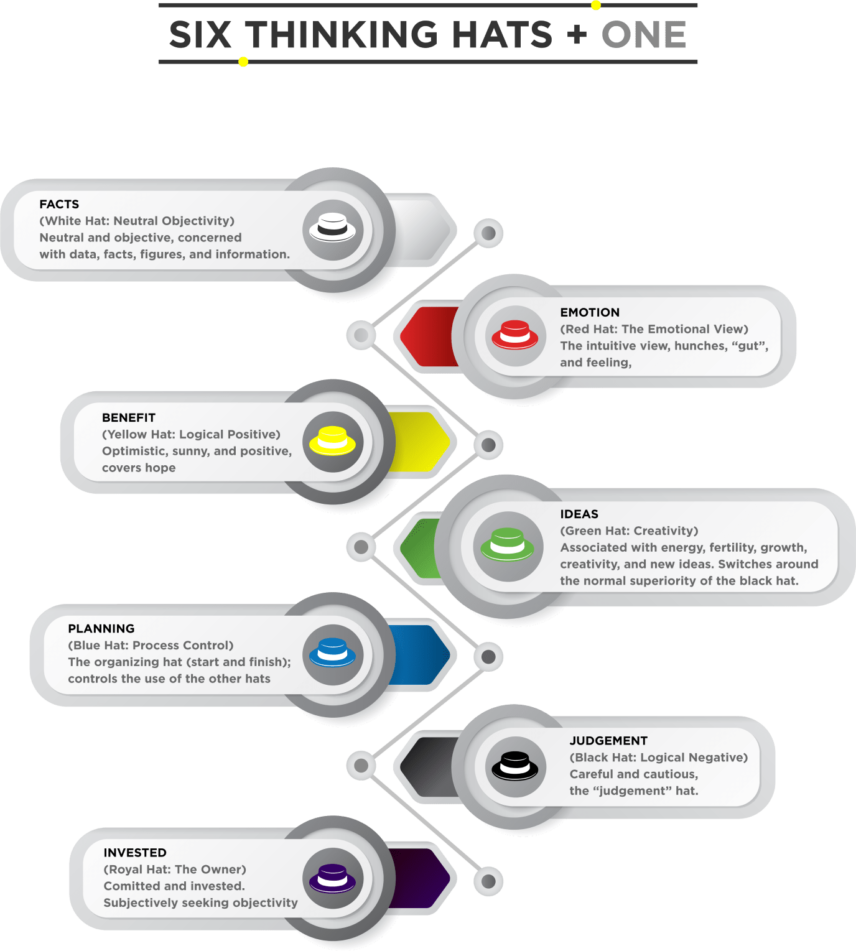Have you ever come to a point when you just hit a dead-end while solving problems at work? A lot of teammates and team leads deal with issues and problems daily, so why do we get stuck, still? Shouldn’t we be masters at tackling problems and finding solutions head on?
It turns out, problem-solving isn’t as easy as it seems, especially when you insist on looking at problems from a particular lens alone.
Enter The 6 Thinking Hats: An innovative brainstorming technique used to view problems from all angles with the sole purpose to each an intended solution. It is an effective tool for decision making and problem solving that uses both sides of your brain. |
It was first coined by Edward de Bono, an innovator in the style of ‘lateral thinking’. In his book. The Six Thinking Hats, he was met with wide critical acclaim for all the usefulness his tool has brought to the business world.
The Six Thinking Hats is a simple, lateral thinking process that involves reframing one’s thoughts of a problem and requires a group or a person see it through different lenses, or in this case, through wearing different hats. This is an effective tool used by leaders to enhance effectivity, focus and productivity.
Each thinking hat represents a frame of thought, a kind of thinking, and a clear function based on the color that a team member can represent during discussions, team meetings and brainstorming sessions.
Where can we apply the 6 thinking hats?

Running Meetings – If you find yourself reaching an impasse in your team. You can use the 6 thinking hats to keep the conversation professional, objective and focused on the problem.

Brainstorming and Generating Ideas – The 6 Thinking Hats can be used to look at a problem and peg for a solution.

Process Improvement and Project Management – On a bigger scale, the 6 Thinking Hats also proves as a useful tool to get yourself “unstuck” from situations at work that demand changes to happen.
What are the 6 thinking hats?

The White Hat
Takes a stand of absolute neutrality looking at all sides of the fence and focusing the attention on facts and figures.

The Red Hat
Is the emotional, gut feeling hat. This is an important hat because it brings into account things such as emotional value, social-economic impact, and simply just if the project “feels right” to even be doing in the first place. This is all based on one’s feelings, or gut instinct and has little to do with facts presented.

The Black Hat
Is the judgmental, no-type of hat that tries to talk about all the cons and drawbacks of the project at hand.

The Yellow Hat
Looks at all the benefits of a project. All the positive things that can come out of it and why it would be a good idea to push for a certain venture.

The Green Hat
Brings forth openness, novelty, and creativity this project can bring to the table. It looks at the project or idea with all the growth it can possibly accomplish. We are talking about someone who sees the potential and tries to find a different scenario that will make it grow.

The Blue Hat
The blue hat is cool and calm, and plans things accordingly. The blue hat is concerned with control, organization, and the use of the other hats.

How to use the Thinking Hats
There are two approaches to using the 6 Thinking Hats: Single Use and Sequence Use.
The Single Use of the 6 thinking hats are symbols or representations of a singular way of thinking that proves necessary for a meeting at hand or a conversation. For example, at some point in time during a meeting, you realize there is a need for creativity and freshness in the approach, so we will all wear our green thinking hats, instead.
While the sequential use of the thinking hats will require the use of certain hats in sequence, depending on the necessity. There is an evolving style, wherein once the facilitator chooses a hat, the next hat is chosen depending on how the conversation pushes forward. Then there is the pre-set style, which is recommended if you haven’t mastered the 6 Thinking Hat styles yet. The preset style simply pre-plans the hats to be used in the discussion.
July is Global Enterprise Agility Month, and Rocket Station seeks to become part of this venture by sharing tips, tricks and tools to help people become better leaders, strategic thinkers and team members.
RELATED STORIES



SHARE
POST A COMMENT


